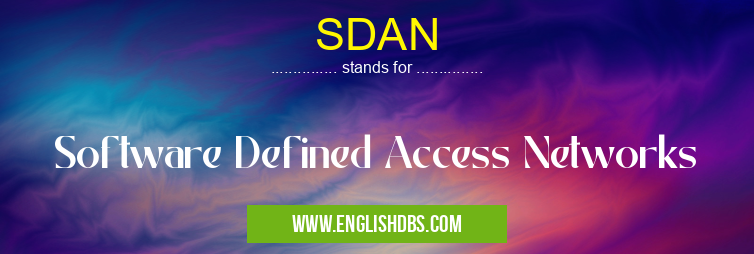What does SDAN mean in SOFTWARE
Software Defined Access Networks (SDANs) are virtualized networking solutions that decouple the control plane from the data plane in access networks, such as home, enterprise, and mobile networks. SDANs provide centralized control and management over the network infrastructure, enabling dynamic configuration, automation, and real-time optimization of network resources.

SDAN meaning in Software in Computing
SDAN mostly used in an acronym Software in Category Computing that means Software Defined Access Networks
Shorthand: SDAN,
Full Form: Software Defined Access Networks
For more information of "Software Defined Access Networks", see the section below.
Key Features of SDAN
- Centralized Control: A centralized controller manages and orchestrates the network, providing a single point of control for network configuration and policy enforcement.
- Virtualization: Network functions, such as routing, switching, and firewalling, are virtualized and can be deployed on commodity hardware.
- Programmability: SDANs are programmable using software-defined networking (SDN) protocols, such as OpenFlow, enabling network automation and customization.
- Flexibility: SDANs allow for flexible and dynamic network configurations to adapt to changing traffic patterns and user requirements.
- Openness: SDANs are designed to be open and interoperable, supporting multi-vendor solutions and integration with existing network infrastructure.
Benefits of SDAN
- Improved Network Agility: SDANs enable rapid deployment of new services and real-time network adjustments, reducing operational expenses and increasing revenue potential.
- Reduced Complexity: By centralizing control and virtualizing network functions, SDANs simplify network management and reduce the need for specialized hardware.
- Increased Efficiency: SDANs optimize network traffic by dynamically allocating resources and reducing congestion, leading to improved network performance.
- Enhanced Security: SDANs provide centralized security management and real-time threat detection, enhancing network security and reducing vulnerabilities.
- Lower Costs: SDANs reduce hardware costs by using commodity hardware and optimize network resources, leading to lower operating expenses.
Essential Questions and Answers on Software Defined Access Networks in "COMPUTING»SOFTWARE"
What is Software Defined Access Networks (SDAN)?
SDAN is a network architecture that separates the control plane from the data plane in access networks. It enables network operators to manage and control their networks centrally, providing greater flexibility, agility, and programmability.
What are the benefits of SDAN?
SDAN offers numerous benefits, including:
- Centralized network management and control
- Improved network flexibility and agility
- Support for new services and applications
- Reduced operational costs
- Enhanced security and reliability
What are the different components of SDAN?
SDAN typically consists of the following components:
- Software Defined Network Controller (SDNC): Centralized control point for managing the network
- Access Points (APs): Devices that connect end-user devices to the network
- Edge Switches: Devices that connect APs to the core network
How does SDAN work?
In SDAN, the control plane and the data plane are separated. The SDNC controls the network configuration and policies, while the APs and edge switches handle the data forwarding. This separation allows network operators to manage the network centrally and make changes quickly and easily.
What is the difference between SDAN and traditional access networks?
Traditional access networks are typically hardware-based and have limited flexibility and programmability. SDAN, on the other hand, is software-based and provides greater flexibility and agility. This allows network operators to adapt their networks to changing requirements and deploy new services more quickly.
What are the future trends for SDAN?
SDAN is evolving rapidly, with new technologies and applications being developed. Some of the future trends for SDAN include:
- Integration with artificial intelligence (AI) and machine learning (ML)
- Support for emerging technologies such as 5G and IoT
- Increased focus on security and privacy
Final Words: SDANs represent a paradigm shift in access network design, enabling greater flexibility, agility, and efficiency. By decoupling the control plane from the data plane, SDANs empower network operators with unprecedented control and visibility over their networks, ultimately enhancing the user experience and driving business value.
